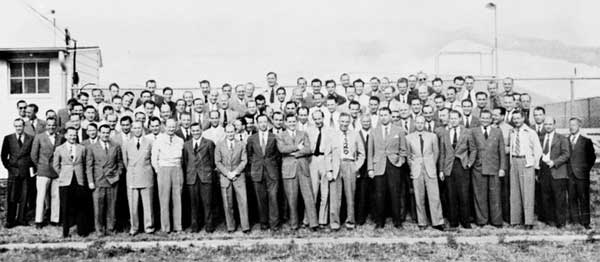World War II:
Operation Paperclip
World War II: Table of Contents | DeNazification | War Refugee Problem
Operation Paperclip (also Project Paperclip) was the code name for the O.S.S.–U.S. Military rescue of scientists from Nazi Germany, during the terminus and aftermath of World War II. In 1945, the Joint Intelligence Objectives Agency was established with direct responsibility for effecting Operation Paperclip.
 |
|---|
Following the failure of the German invasion of the Soviet Union (codenamed Operation Barbarossa), and (to a lesser extent) the entry of the U.S. into the war, the strategic position of Germany
was at a disadvantage since German military industries were unprepared
for a long war. As a result, Germany began efforts in spring 1943
to recall scientists and technical personnel from combat units to
places where their skills could be used in research and development:
“Overnight, Ph.D.s were liberated from KP duty, masters of science were recalled from orderly service, mathematicians were hauled out of bakeries, and precision mechanics ceased to be truck drivers.” — Dieter K. Huzel
The recalling first
required identifying the men, then tracking them and ascertaining their
political correctness and reliability, before being recorded to the
Osenberg List, by Werner Osenberg, a University of Hannover
engineer-scientist, head of the Wehrforschungsgemeinschaft
(Military Research Association). In March 1945, a Polish laboratory
technician found the pieces of the Osenberg List in an improperly
flushed toilet. Major Robert B. Staver, U.S.A., Chief of the Jet
Propulsion Section of the Research and Intelligence Branch of the U.S.
Army Ordnance, London, used the Osenberg List to compile his Black List
of scientists to be interrogated, headed by rocket scientist Wernher von
Braun.
The original, unnamed
plan — to interview only the rocket scientists — changed after Maj.
Staver sent Col. Joel Holmes’s cable to the Pentagon, on 22 May 1945,
about the urgency of evacuating the German technicians and their
families as “important for [the] Pacific war”. Most of the scientists
were rocketeers of the V-2 rocket service; initially housed with their
families in Landshut, Bavaria.
On 19 July 1945, the U.S. JCS designated the handling of the Nazi
scientists and their families as Operation Overcast, but when their
housing’s nickname, “Camp Overcast”, became common, conversational
usage, Operation Overcast was renamed Operation Paperclip. Despite the
effort to secrecy, by 1958, much about Operation Paperclip was
mainstream knowledge, mentioned in a panegyric Time magazine article about Wernher von Braun.
In early August 1945,
Colonel Holger N. Toftoy, chief of the Rocket Branch in the Research
and Development Division of Army Ordnance, offered initial one-year
contracts to the rocket scientists. After Toftoy agreed to take care of
their families, 127 scientists accepted the offer. In September 1945,
the first group of seven rocket scientists arrived from Germany at Fort
Strong in the US: Wernher von Braun, Erich W. Neubert, Theodor A.
Poppel, August Schulze, Eberhard F. M. Rees, Wilhelm Jungert and Walter
Schwidetzky. Eventually the rocket scientists arrived at Fort Bliss, Texas for rocket testing at White Sands Proving Grounds as “War Department Special Employees.”
In early 1950, U.S.
legal residence for some “Paperclip Specialists” was effected through
the U.S. Consulate in Ciudad Juárez, Chihuahua, Mexico;
from which country the Nazi scientists legally entered the U.S. In
later decades, the War time activities of some scientists were
investigated — Arthur Rudolph linked to the Mittelbau-Dora slave labor camp, Hubertus Strughold implicated with Nazi human experimentation.
Eighty-six
aeronautical engineers were transferred to Wright Field, which had
acquired Nazi aircraft and equipment under Operation Lusty.
The United States
Army Signal Corps employed 24 specialists — including physicists Drs.
Georg Goubau, Gunter Guttwein, Georg Hass, Horst Kedesdy, and Kurt
Levovec; physical chemists Professor Rudolf Brill and Drs. Ernst Baars
and Eberhard Both; geophysicist Dr. Helmut Weickmann; technical optician
Dr. Gerhard Schwesinger; and electronics engineers Drs. Eduard Gerber,
Richard Guenther and Hans Ziegler.
The United States
Bureau of Mines employed seven German synthetic fuel scientists in a
Fischer-Tropsch chemical plant in Louisiana, Missouri in 1946.
In 1959, ninety-four Operation Paperclip men went to
the U.S., including Friedwardt Winterberg and Friedrich Wigand. Through
1990, Operation Paperclip immigrated 1,600 Nazi personnel, with the
“intellectual reparations” taken by the U.S. and the U.K. (patents and industrial processes) valued at some $10 billion dollars.

No comments:
Post a Comment